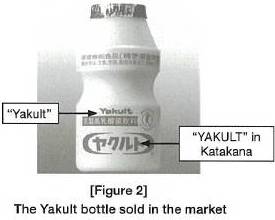Shape of a Yakult drink bottle recognized as a 3D Trademark
地域:日本
業務分野:商標
カテゴリー:その他
『Yuasa and Hara Intellectual Property News』Vol.32所収、
ユアサハラ法律特許事務所、2011年8月
飯田 遥
Shape of a Yakult drink bottle recognized as a 3D Trademark
1.Introduction
You may easily recall the unique shape of a “Yakult drink” Bottle. On November 16, 2010, the Intellectual Property High Court (hereinafter “IP High Court”) issued a decision which held that the shape of the Yakult mini bottle without any words or distinctive elements (hereinafter “Yakult bottle,” shown in Figure 1 below) has acquired a secondary meaning for the goods “lactic acid drinks” in Class 29. This is the second case following the recent Coca-Cola bottle case ((Gyo-ke) 10215/2007, IP High Court, May 29, 2008), which was successfully handled by Yuasa and Hara, where the Japanese IP High Court recognized the inherent distinctiveness of the shape of a container of the products. In this decision, similar to the Coca-Cola bottle case, the IP High Court judged that the shape of the Yakult bottle has acquired a secondary meaning, though the famous word mark “Yakult” in Katakana or in Roman letters is shown in an eye-catching manner on the actual Yakult bottles sold in the markets (see Figure 2 below). For the claimant Yakult Honsha Co., Ltd., it was the second attempt to register a three-dimensional trademark for the shape of a Yakult bottle, as the first try failed in 2000 ((Gyo-ke), 474/2000, IP High Court, July 17, 2001).
2.Examination History
The claimant Yakult Honsha Co., Ltd. filed a trademark application for a three-dimensional mark for the shape of a bottle of Yakult drinks without any words or distinctive elements. The designated goods are lactic acid drinks in Class 29. The applied-for mark is shown in Figure 1 above.
The Appeal Board of the JPO sustained the examiner’s refusal stating the following two points: a) the applied-for trademark lacks distinctiveness, as it merely indicates the shape of a container of the designated goods; and b) as the famous word mark “Yakult” in Katakana or in Roman letters is attached to the Yakult bottles that are actually sold in markets as shown in Figure 2 above, the shape of the Yakult bottle itself had not acquired a secondary meaning under Article 3, Paragraph 2 of the Trademark Law.
To overcome this decision, Yakult Honsha Co., Ltd. filed an appeal to the IP High Court. In the trial at the IP High Court, the claimant tried to refute only point b), asserting that the Yakult bottle itself had acquired a secondary meaning by extensive use over the years.
3.Judgment by the IP High Court
3.1 The meaning of Article 3, Paragraph 2 in connection with the examination of a threedimensional trademark
The IP High Court pointed out, as a premise, the basic concept of Article 3, Paragraph 2 of the Japanese trademark law with regard to the examination of a three-dimensional trademark as follows:
“In order that a three-dimensional trademark acquires secondary meaning under Article 3, Paragraph 2, it is necessary that an applied-for mark should be identical with the mark that is actually used in the markets. Further, it is necessary that, as a result of extensive use of the mark, consumers are able to recognize the goods/services as those pertaining to a business of a particular person. In such a case, however, even if commercial names or other word marks are attached to the goods of a three-dimensional shape which are actually sold in the market, whether applied-for trademark acquires a secondary meaning or not should be examined by focusing on the threedimensional shape itself without such elements.”
3.2 Use of the Yakult bottle
Based on the above premise, the court found the following facts:
a) Though the bottle has a simple shape focusing on the functionality of the beverage container (e.g. easy to grasp and drink), it was a new, innovative design as a container of lactic acid drinks at that time.
b) The Yakult bottle has been used for Yakult drinks for more than 40 years without any change to its design.
c) The sales figures of Yakult drinks contained in the Yakult bottles have been amazingly high. Sales have always topped more than 30 billion yen since 2000. In 2008, the sales of Yakult drinks reached 45.9 billion yen.
d) During 1998 to 2007, the market share of Yakult Honsha Co., Ltd. always exceeded 50% in the field of lactic acid drinks. Actually, the company has dominated over 42% of that field with just its Yakult drink.
e) Yakult Honsha Co., Ltd. has spent a great amount of money on advertising the Yakult drink every year. Advertising accounted for 7.6 billion yen in 1988 and reached 9.5 billion yen in 2005. Furthermore, in the advertising, the characteristics and the advantages of the shape of the bottle have been emphasized.
f) In questionnaire surveys conducted in 2008 and 2009, more than 98% of respondents who saw the Yakult bottle answered that they associated the bottle with the Yakult drink.
g) Though at least 12 types of lactic acid drinks using bottles similar to the Yakult bottle have been sold by third parties, all of them appeared on the market after the Yakult bottle made its appearance.
h) According to a website, consumers who have encountered other lactic acid drinks using bottles similar to the Yakult bottle believed that such bottles were counterfeit goods of the Yakult bottle.
3.3 Conclusion of the IP High Court
Based on the above facts, the IP High Court concluded that the Yakult bottle was individually recognized as a trademark distinguishing the claimant’s products from others. The IP High Court further added that, even if the famous word mark “Yakult” in Katakana is attached to the Yakult bottle sold in the market, it is apparent that the Yakult bottle itself individually attracts the attention of consumers more readily than the word marks borne thereon, especially in view of the result of questionnaire surveys (fact (f) above) and the recognition of consumers (fact (h) above).
4.Comparison with past cases
In the 2000 decision of the first Yakult bottle case, the IP High Court denied the secondary meaning of the Yakult bottle mainly because the applied-for mark and the mark used in the market were not identical with each other, emphasizing that it was not the Yakult bottle itself but the famous word mark “Yakult” attached to the bottle actually sold in the market that worked as a trademark.
As for the judgment of a three-dimensional trademark regarding the shape of goods, identification of the applied-for mark and the mark used is strictly required. On the other hand, distinctive elements such as word marks are normally attached to the products sold in the market. Therefore, there are numerous cases so far where registrations of three-dimensional trademarks composed solely of the shape of products have been rejected as is the case in the first Yakult bottle case.
However, this examination trend was changed by the Coca-Cola bottle case and the Court has become more reasonable than before. The Coca-Cola bottle case has profound significance in that it established a legal theory where even if a famous mark is attached to a container that is actually sold in the market, whether the applied-for trademark has acquired a secondary meaning should be examined by focusing on the three-dimensional shape itself without such elements. Following the establishment of this new legal theory, the Yakult bottle was regarded as a distinctive three-dimensional trademark by way of the second trial.
In this way, the second Yakult bottle case reached the same conclusion as that in the Coca-Cola case. However, there is a remarkable difference between these two cases. In the second Yakult bottle case, though at least 12 lactic bottles resembling the Yakult bottle existed in the market, the Court judged that the Yakult bottle has acquired a secondary meaning. In the Coca-Cola bottle case, no other similar bottles existed in the market because of the extensive countermeasures against counterfeit goods. On this point, the Court in the second Yakult bottle case expressed the following opinion:
“As long as the consumers recognize similar bottles in the market as “counterfeit goods of the Yakult bottle,” and so long as the Yakult bottle is sharply discriminated from other similar bottles in the market, distinctiveness of the Yakult bottle should not be lost only due to the existence of other similar bottles or counterfeit goods.”
Then, the Court judged that the said recognition of consumers can be successfully proved by the facts of the above fact g) all similar bottles appeared after the Yakult bottle appeared in the market and h) most of the consumers believed that such bottles were counterfeit goods of the Yakult bottle. Further, the Court added that the result of the questionnaire indicates it should be firmly presumed that the Yakult bottle itself obtained distinctiveness.
On this point, the second Yakult bottle case represents a new step in the judgment of three-dimensional trademarks in Japan.
5.Postscript
The Court issued brand-new decisions for three-dimensional trademarks for perfume bottles resembling human body under the brand of JEAN PAUL GAULTIER ((Gyo-ke) 10366/2010, IP High Court, April 21, 2011, (Gyo-ke) 10406/2010, IP High Court, April 14, 2011). Including these recent cases, we need to focus on future trends regarding three-dimensional trademarks in Japan.
商標分野の他の法律情報
お電話でのお問合せ
03-3270-6641(代表)



